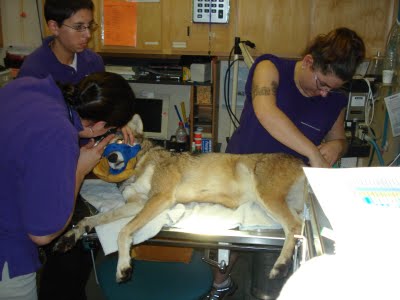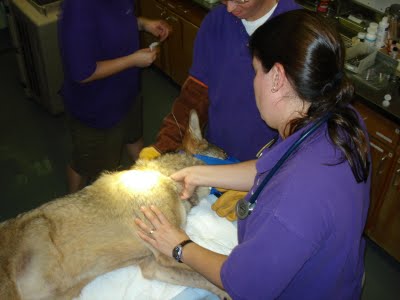 Our red wolves got their annual physicals yesterday, October 5.
Our red wolves got their annual physicals yesterday, October 5. We’ve had our hands on the female wolf a bunch because of a few different medical issues that have come up while she’s been here, but this was the first time we caught up our male.
We’ve had our hands on the female wolf a bunch because of a few different medical issues that have come up while she’s been here, but this was the first time we caught up our male.
What you see in the photos is pretty typical: Even though the wolf is sedated, we put a muzzle on. One keeper (Marilyn, with gloves on) watches the head for any signs of movement or waking.
Katy and Dr. Carter work through the physical checklist to make sure everything gets done.
We learned that our male wolf weighs about 71 pounds and had a lot of tartar build up on his teeth (down from the 78 pounds he weighed when he arrived. All the Keepers thought the male had lost a bunch of weight but I believe Kent was the closest in the unofficial office pool). Our female wolf weighs about 52 pounds. Both of the wolves will go on antibiotics: the male has a small wound on his lip, and the female had a long gash on her back above her tail. They could have got into a fight over who knows what, maybe some deer meat we put in. Both will be fine. If you come by the Museum, the female will be the one missing the hair around her bum (it was shaved to check it out and stitch it up).
If you want to learn more about these wolves, click on the following wolf posts from the past:
I have been to see the wolves quite a few times and am concerned about the pacing of the wolf in the back of the enclosure. From all of my studies of animals, this is a sign of distress or boredom. What is being done about this?
Anonymous:This wolf, 1369, came to us after living at an institution not open to the public. He rarely even saw the people who worked with him. We have noticed him, slowly, getting more used to life here. We have also noticed that he paces less than he used to, and after hours is calmer.With that said, the wolves get are monitored by a professional and caring keeper staff, get daily enrichment, and have regular veterinary care to make sure they are as healthy as possible.Your concerns are valid, and are concerns of our own as well.Please phone the Museum or email through the "contact us" on our website so I can communicate more with you.Thanks for the appropriate and insightful comment.